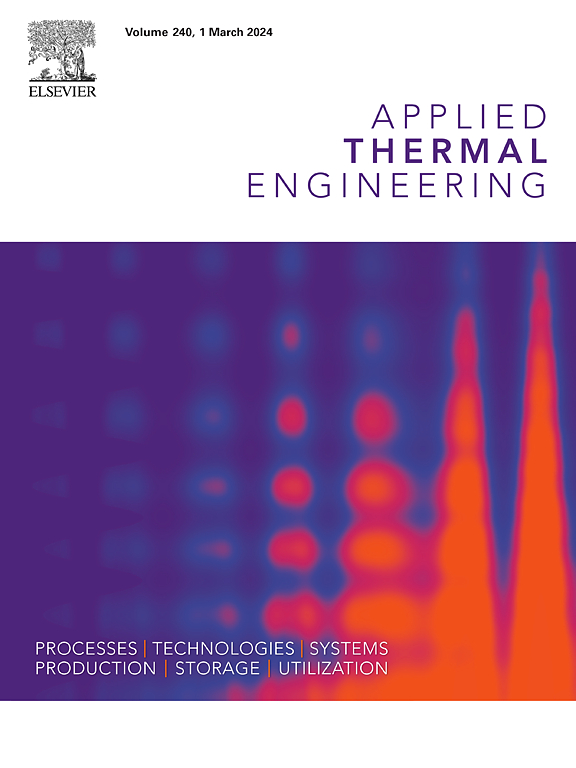Numerical investigation on the heat transfer and pressure loss characteristics of precooler under negative pressure
IF 6.1
2区 工程技术
Q2 ENERGY & FUELS
引用次数: 0
Abstract
Precoolers have garnered considerable attention owing to their applications in aerospace and industrial fields. Nonetheless, there is a paucity of research concerning the performance of precoolers under conditions of extremely low pressure. This study conducts a numerical analysis of the heat transfer and pressure loss characteristics of a plate-fin precooler operating under negative pressure, considering the coupled heat transfer interactions among the hot fluid, solid wall, and cooling fluid. The comprehensive performance and flow field on each side of the precooler are investigated. Moreover, the impact of negative pressure on the heat transfer and pressure recovery performance of the hot fluid in the rectangle channel is evaluated. The results show that, even under operating conditions with pressures below 30 kPa and inlet temperatures exceeding 1100 K, the precooler attains a pressure recovery coefficient greater than 95.6 % and achieves a temperature drop exceeding 43.2 % for the hot fluid as the mass flow rate ranges from 0.205 kg/s to 0.564 kg/s. Additionally, the heat transfer coefficient of the hot fluid is less than 1/40 that of the cooling fluid, resulting in increased thermal resistance between the hot fluid and the wall. Consequently, a distinct thermal boundary layer develops between the hot fluid and the wall, which is not present between the cooling fluid and the wall. Furthermore, the performance of heat transfer and pressure recovery for the hot fluid exhibits considerable variability with changes in static pressure at a constant inlet velocity. However, a turning point is observed when these parameters are evaluated in terms of the inlet Reynolds number. At low Reynolds numbers, both the heat transfer coefficient and the friction factor remain relatively stable, notwithstanding fluctuations in static pressure. Conversely, at higher Reynolds numbers, a reduction in static pressure negatively influences these factors. For instance, when the static pressure is 10 kPa, the associated Reynolds number is 500. Nevertheless, the Reynolds number at which this turning point occurs escalates with an increase in static pressure.
负压下预冷却器传热和压力损失特性的数值研究
预冷却器因其在航空航天和工业领域的应用而备受关注。然而,有关预冷却器在极低压力条件下性能的研究却很少。考虑到热流体、固体壁和冷却流体之间的耦合传热相互作用,本研究对负压下运行的板翅式预冷却器的传热和压力损失特性进行了数值分析。研究了预冷却器各侧的综合性能和流场。此外,还评估了负压对矩形通道中热流体传热和压力恢复性能的影响。结果表明,即使在压力低于 30 kPa 和入口温度超过 1100 K 的工作条件下,预冷却器的压力回收系数仍大于 95.6%,热流体的温度下降超过 43.2%,质量流量范围为 0.205 kg/s 至 0.564 kg/s。此外,热流体的传热系数小于冷却流体的 1/40,导致热流体与壁面之间的热阻增加。因此,热流体和壁面之间形成了明显的热边界层,而冷却流体和壁面之间则没有。此外,在入口速度不变的情况下,热流体的传热和压力恢复性能随静压的变化而变化很大。然而,当根据入口雷诺数对这些参数进行评估时,会发现一个转折点。在雷诺数较低时,尽管静压有波动,但传热系数和摩擦因数都保持相对稳定。相反,在雷诺数较高时,静压的降低会对这些系数产生负面影响。例如,当静压为 10 千帕时,相关的雷诺数为 500。然而,随着静压的增加,出现这一转折点的雷诺数也会增加。
本文章由计算机程序翻译,如有差异,请以英文原文为准。
求助全文
约1分钟内获得全文
求助全文
来源期刊

Applied Thermal Engineering
工程技术-工程:机械
CiteScore
11.30
自引率
15.60%
发文量
1474
审稿时长
57 days
期刊介绍:
Applied Thermal Engineering disseminates novel research related to the design, development and demonstration of components, devices, equipment, technologies and systems involving thermal processes for the production, storage, utilization and conservation of energy, with a focus on engineering application.
The journal publishes high-quality and high-impact Original Research Articles, Review Articles, Short Communications and Letters to the Editor on cutting-edge innovations in research, and recent advances or issues of interest to the thermal engineering community.
 求助内容:
求助内容: 应助结果提醒方式:
应助结果提醒方式:


